
A Question to Ask Your Inspector
Search the internet and you can find a raft of questions to ask a home inspector. Many will have a variety of questions, usually involving cost, expertise, experience, and availability. Quite a few have a question along the lines of “Do you participate in continuing education programs?”
It is an okay question that I have never had a client ask me. Why is it only an okay question? Because it is a straight yes-or-no. Let me give you a better question.
What changes have you made to your inspections or reports because of continuing education?
The difference between the two is dramatic. In the first case, the inspector either has or has not done continuing education. In the State of Washington, the answer should always be yes, they have. It is mandated that home inspectors complete 24 hours of continuing education ever licensing cycle. What isn’t mandated is taking classes that expand the inspector’s knowledge. The individual inspector can literally and legally take exactly the same classes each cycle and get credit for it.
By moving past the CE question to discuss how that has changed the inspector’s process and reporting, you can get a reasonable idea of whether that inspector actually applies the new knowledge on behalf of his customers. More than a canned response about how long they’ve done inspections or what contracting work they used to do, this question cuts to the heart of their expertise and professionalism.
A good inspector is likely to do far more than the minimum in continuing education. As an example, I’m taking the 12th of July off to attend a training seminar put on by Washington State University on the latest changes in the Washington Residential Energy Code. This class won’t count for CE’s since it isn’t approved, but I will learn a wealth of good information and some of that will find its way into my reports.
Likewise, when I went to Seattle in March for the Western Washington chapter of ASHI seminar that had course approvals that counted toward my total, I picked up a wealth of new information. Not all of it is immediately useful, but it does inform me of potential issues to be aware of so that I can provide good advice.
I make two trips per year to western Washington specifically for the seminars. I take my computer with me so I can make changes to my report structure while the information is fresh. Since I take continuing education seriously, it impacts my business very directly.
“Describe any deficiencies of these systems or components.”
Since we do have continuing education requirements in Washington State, every inspectors reports ideally should be evolving. The quote above, taken right from the Washington State Standard of Practice for Home Inspections, means that as the inspector learns new things, it should be reported. Be leery of any inspector who is still doing reports the same way as they did five or ten years ago. Either they are not applying the knowledge they have acquired or they aren't actually committed to continuing education as self-improvement.
How do you verify?
Ask your agent who’s reports have changed the most over the last five years. They see the reports on a regular basis. In this region where we have small communities, they should be able to answer that question about the inspectors they are referring.
Who swiped my square footage?
It's getting to the point where I much prefer doing a 1960's rambler over a new home. At least with them, I know what kind of problems to expect. Not so with new homes - and our builders are getting sloppy and the municipal building inspectors are missing defects, a lot of them.
Case is point, yesterday I did a new home, built last year and occupied in December. I followed my usual protocol of inspecting the exterior first, then roof, then interior spaces, starting at the finished basement.
I started at the store room at the back of the house, where the furnace was located. Lots of stuff in there in the rectangular room. That's when a warning bell went off. Made a "unh?" sound and ran up the stairs to fetch my laser measure.
Measured upstairs, from the sliding door to the far edge of the kitchen. 24'2". Add a six-inch wall. Measured the width of the laundry room. 11'1". Total, 35'9". Got it.
Ran back downstairs. Measured from one side of the store room to the other. 24'7".
Ran back upstairs, hurried past my clients. Got into the laundry room and stomped with my heel. Echo-y sound, so definitely not slab-on-grade. Basement or crawlspace. Checked the only closet. No access hatch. Stomp to make sure. Hatches bounce, making them sound slightly different that regular sub-floors. Nope.
Meanwhile, my clients are looking at me as though I am a touch daft. "What's under here?" I asked, pointing to the laundry room floor.
More looks questioning my sanity. Fortunately, I've worked with this couple before, so I get the benefit of the doubt.
I explain myself, that the dimensions don't match. Off we go, down the steps, 'round the corner, and we collectively stare at the store room wall. The husband asks if blueprints would help. "Absolutely!" They're friends with the sellers (it's a FSBO) so they text about plans and the crawlspace.
The reply comes back - they have no plans, nor is there a crawlspace.
Au contraire, I think, got to be something under there. It's not a slab, and it isn't a basement, so crawlspace is the default answer.
This, too, gets explained to the clients. They ask why I need to get in there, given it is a new home. I point out that I need to verify the insulation, vapor barrier, ventilation (I didn't see vents on the exterior wall, so it may not be vented, another code violation), and make sure it is dry. If it isn't dry, we have a potential mold and rot issue waiting for us.
Termites in Pullman are a very rare occurrence, fortunately, or I'd add them to my list of worries.
My clients are bright; they get it. They also don't panic as we analyze the best way to create access. The home is still under warranty, so the builder will be doing the work.
I felt pretty pleased. Like Sherlock in the story "Silver Blaze" with the dog that did not bark, I had done the harder part of inspecting. Any one can see what is there, but a really good inspector will recognize what isn't. It was a good catch.
Gregory (Scotland Yard detective): "Is there any other point to which you would wish to draw my attention?"
Holmes: "To the curious incident of the dog in the night-time."
Gregory: "The dog did nothing in the night-time."
Holmes: "That was the curious incident."
Building Permit Research
Curious if the home you are considering purchasing has a Certificate of Occupancy?
One of my clients was, on a relatively new (six year-old) custom home, and took the time to go down to the local Building Department to do the research. To the surprise of both of us, a CO had never been issued on the home. Since I had already referred him to a structural engineer due some very odd cracking and bowing in the walls, this was the final straw in the deal.
That was a couple of weeks ago. This past week, while resolving a disagreement on electrical bonding with a contractor, I discovered that another home that I had recently inspected never had a permit purchased or an inspection performed on a brand new roof.
If home inspections were done to the same standard as a commercial inspection, visiting the Building Department for document research would be automatic. Not so for home inspections.
Maybe that should change.
I'm am now including an add-on service for residential inspections. For $125.00, I will gather the available relevant documents including permit applications, inspection reports, and Certificates of Occupancy and deliver them to you as a .pdf file.
I am recommending this for homes 25 years old and older, homes reported to have been recently remodeled, and custom built homes. The reasoning is that it takes some time in the house's lifecycle to get to the remodel and retrofit phase. Roofs and mechanical equipment usually do not need change-out earlier. Remodels trigger their own permit requirements. Custom homes fall across a broad spectrum of professional competencies. In the case above, the builder went out of business, leaving the current owner in a major lurch.
I do not recommend it for spec-built homes. Companies such as Copper Basin and Hayden Homes are consistent about acquiring the necessary permits. They are too big to fly under the radar for the Building Departments.
A minimum of three business notice required.
Surviving the Home Inspection Hits #1 On Kindle!
Very excited that my book, Surviving the Home Inspection, hit the top spot (probably briefly given the ephemeral nature of Amazon's bestseller lists) in the Kindle store in the Buying and Selling Homes category.
I'm already planning my next project- deciphering FHA, VA, USDA, inspections for the sellers.
How Much Difference Does Insulation Make?
I did an inspection in Lewiston late last year on a very cute little bungalow near Normal Hill. The home was classic brick with trees lining the street in front. The clients were a young couple buying their first home.
One the findings that we came up with is that there was nearly no insulation. The home had an old beast of a furnace that kept the home warm - when it ran, and it definitely like to do that.
Jack asked me for some advice about how to handle this. We talked about the advantages and disadvantages of blown fiberglass and blown cellulose. One nice thing about our local Home Depot is that they will essentially lend you the equipment to insulate the home yourself if you purchase a set amount of the insulation from them. It's a pretty good deal, one that I took advantage of in my home.
Jack sent me these pictures, a before-and-after of the attic space. It's pretty impressive, though it's going to make it a lot tougher for the next inspector to traverse the attic.
Jack put in about a dozen inches of new insulation. One of the advantages of the blown cellulose that he chose is that it air seals much better than fiberglass. It's also much less expensive.
It always makes me happy when I get a chance to see my advice make a positive difference for the people that I work with. In this case, it's a young couple who just spent one afternoon and made their house much more affordable from an operating expenses perspective.
How more affordable?
Jack sent me the numbers - bear in mind that this has been a really mild winter, so the numbers are a little lower than in a cold year.
- Month 1 - $209 for gas and electric.
- Month 2 - $125 for gas and electric.
So, the bill dropped by 40 percent over the course of a month. Pretty darned impressive and I'm awfully happy for the family. Good job to them!
Changes Abound
I haven't posted regularly to the blog. Bad Paul.
I did, however, do a full site redesign, and hopefully the site will be easier to use and easier on the eyes. I've moved the blog off the landing page now that I have a decent looking site.
Bells and whistles are coming - some are still in, like online scheduling. A new feature is the ability to sign the inspection agreement electronically. I'm looking at putting a means for paying online as well - I know it sounds simple but the federal regulations, hoops that come in a multitude of sizes and heights, make it a bit interesting.
You might also notice a name change. I've left the NPI family. This was done at my request and based solely on the changes that we've had in life - the addition of three sons-in-law and six grandchildren, some success in publishing. With the additional commitments of time to personal ventures, I didn't feel that I could properly abide by the requirements of the franchise. Roland Bates, President of NPI, was enormously gracious in releasing me from the non-compete clause in the contract.
For years, I've been the hardest working inspector in the region, frequently working seven days a week. I'm looking to drop that to five and a half days per week. Totally selfish, I know.
I've eliminated a few things, most notably the toll-free number. In an age on unlimited long distance calling on cell phones, the expense does not make sense.
Still coming:
- a complete redesign of my inspection report with the aim of making it more informational and more user-friendly.
- A course for inspectors on residential fire suppression systems
- My book for home sellers, Surviving the Home Inspection (available March 15th)
Should be an exciting year. May yours be equaling exciting and fulfilling!
Play day in a crawlspace!
I've had folks tell me that you couldn't pay them enough to go into a crawlspace. 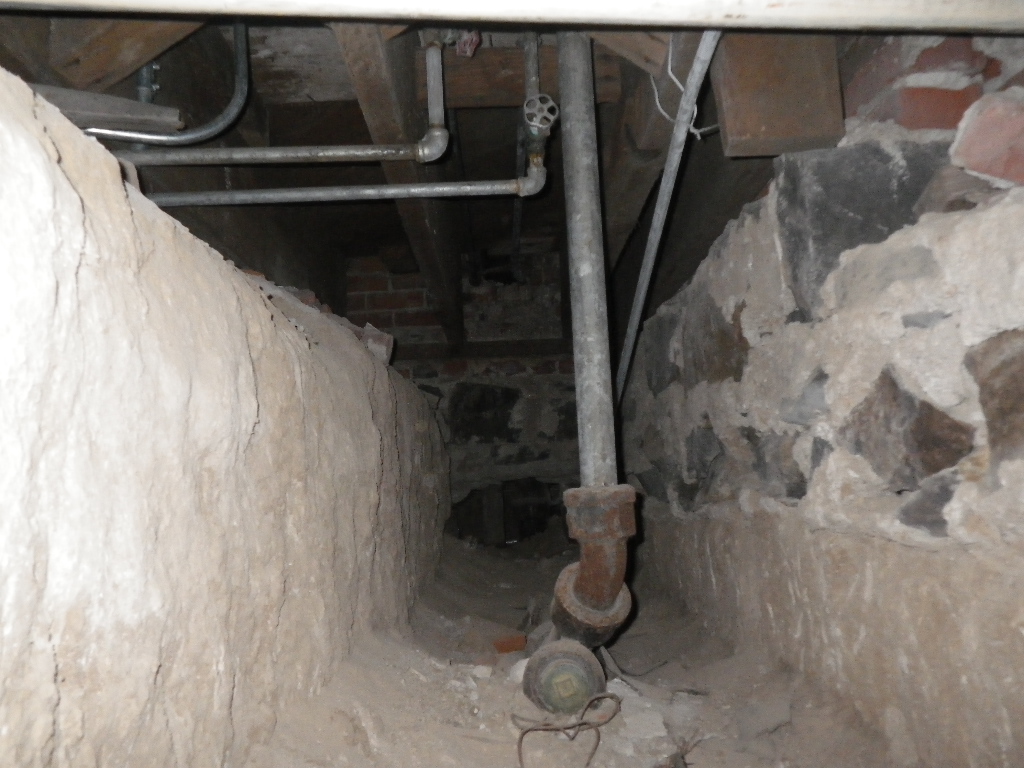 I usually don't have that problem. Today, though, I did it for free.
I usually don't have that problem. Today, though, I did it for free.
Why? A) Because it was a 120 year old building that I knew I'd end up referring to an engineer; B) it was a 120 year old building that was totally cool to check out. Went from one basement, all the way through to the other basement addition, climbed out on a piece of abandoned equipment and had to climb up the old elevator shaft on a rickety old homemade wood ladder wired onto some old conduit.
The Antidote for Nastigrams
I wonder sometimes whether home inspections matter a darn given that I get nastigrams from sellers and their agents with depressing regularity. Then I get this from a client, via email: "Hi Paul, I wanted to write and thank you for recommending I get the gas heat stove serviced in the house on Van Buren St you inspected for me in the Spring. That recommendation saved my life, and my dog's life. "
It matters.
Is Your Attic Like A Dry Sauna?
Summer time has arrived in Lewiston and Clarkston with it's usual suddenness by bursting upward 20 degrees in just few days to bust the 100 degree barrier. Fortunately, as they say, it's a dry heat.
Pretty much what I expect from attics this time of year.
High attic temperatures are not uncommon and, to a small extent, unavoidable. The average roof acts as a large solar energy collector and, depending on the axis of the house, can accumulate very high heat loads. My home, orientated with a east-west main axis, has extensive roof exposure to the south that matches the arc of the sun through the sky. Ideal when I someday add solar PV to the roof, it now acts to increase my heat loads.
High attic temperatures cause several problems inside and outside the home.
Inside, the heat places an increased load on any cooling systems that you have. I've measure ceiling temperatures as high as 120 degrees from the heat generated in the attic. The less insulation you have, the more pronounced (and expensive in utility costs) this becomes. In high humidity environments, this is even worse due to the 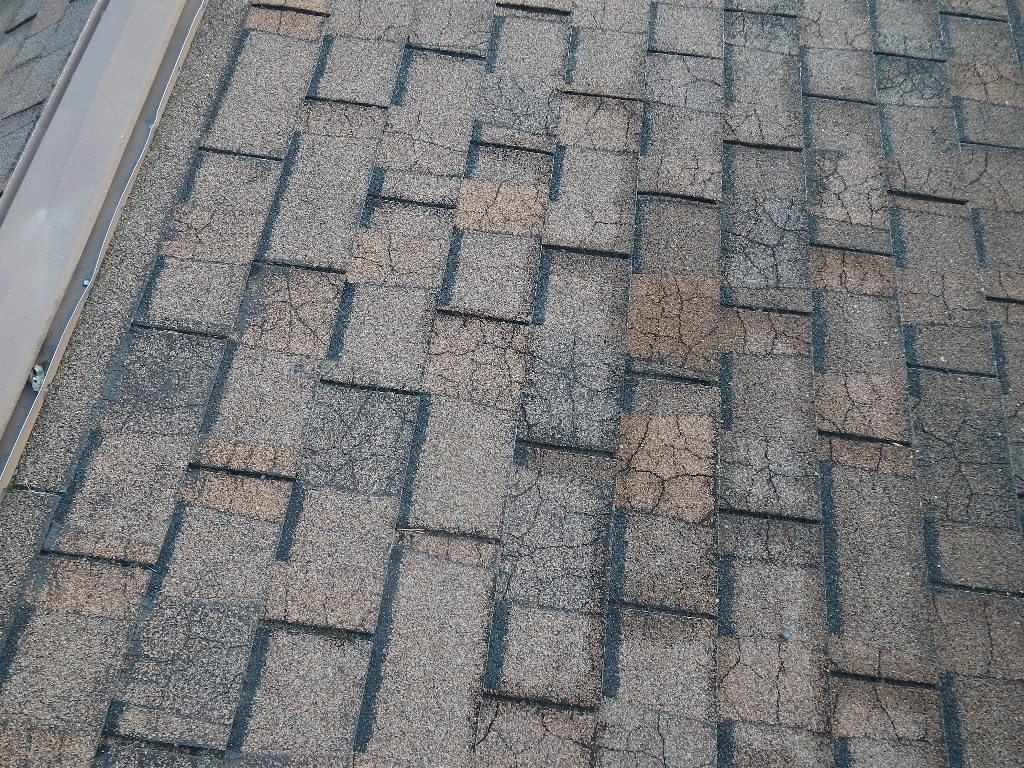 nature of water and its ability to act as a heat sink, absorbing the energy. To balance it out, you end up running the air conditioner longer, adding to it's wear.
nature of water and its ability to act as a heat sink, absorbing the energy. To balance it out, you end up running the air conditioner longer, adding to it's wear.
On the exterior, shingles are subject to thermal cracking. That is, the backing material of the shingles, usually fiberglass, is impregnated with asphalt and over-laid with granules. When the roof temperature climbs, these materials go through a wide range of expansion and contraction, but not at the same rate. The backing material can split or the asphalt cracks, just as you've probably seen it do in a driveway.
Either way, you have shingle damage that will lead to early failure.
Preventative measures include improving the ventilation in the attic. Too little ventilation traps energy as the air becomes superheated. My record for attic temperatures was 154 degrees. I wasn't in there long and it took a good hour to recover. 140's are not uncommon.
Attic ventilation can be improved by ensuring that the appropriate venting is in place. Often I see ridge vents improperly cut. Too narrow a vent does not allow enough hot air to escape, raising the temperature. The same will happen if there is no ridge vent and the static or gable vents don't move enough air.
Another common defect is to have too little air entering the attic space or from the wrong location. Older homes may only have gable vents located of either end of the home. Building science has demonstrated that this creates an air passage way flowing directly from gable to gable without ventilating the lower reaches of the roof assembly.
Improving this in the short term can be as easy as adding new soffit vents to improve air intake, adding a ridge vent (or having it properly cut), or adding an attic fan to increase air movement. All of these, by the way, have beneficial effects on mold and fungus growth.
A longer term approach is to plant trees carefully, determining where they will provide the maximum amount of shade without endangering the home.
Remember that southern face on my house? I have a 100 year old walnut tree on that side and, on the east, a quaking something-or-other (I'm a home inspector, not an arborist. Sorry.) The old folks had the right idea, a century ago.
They did forget to plant on the west corner. I've put in an Asian pear tree. It will be a few years until it gets tall enough but I can wait. When it does get big, it's a two-fer: shade and fruit.
Governor Inslee's Executive Order on Energy Efficiency
Governor Jay Inslee has issued an Executive Order EO 14-04 yesterday that will mandate significant changes in how the residents and businesses of the state will obtain and use energy.
The State Building Code Council is tasked with:
develop, and implement to the extent possible and consistent with state and federal law, a new statewide program to significantly improve the energy performance of both our public and private buildings, taking into account existing state and utility efforts. The program must accelerate the cost-effective energy efficiency retrofit of existing buildings, with a support system that provides information, consumer protection, and assistance to businesses and homeowners. The program must ensure that all new buildings are as energy-neutral as possible, with advanced envelopes, efficient appliances, on-site generation, smart controls, and other features, where practicable.
This change will affect rental property first as evident in the third bullet point:
Support vulnerable and low-income populations through weatherization assistance, setting minimum standards for rental housing energy efficiency, . . .
I fully expect that the provisions that Governor Inslee has set forth will lead to large changes in the manner in which homes are constructed and the way that remodeling is done. I also anticipate that these changes will be relatively expensive to implement.
Anti-tip Bracket
I had a new stove delivered to the house. My wife said the installers were wonderful except . . . they didn't install the anti-tip bracket. I'll do it later, of course, but it's part of the manufacturer's recommendations. Pros should know this and get them in for their customers. 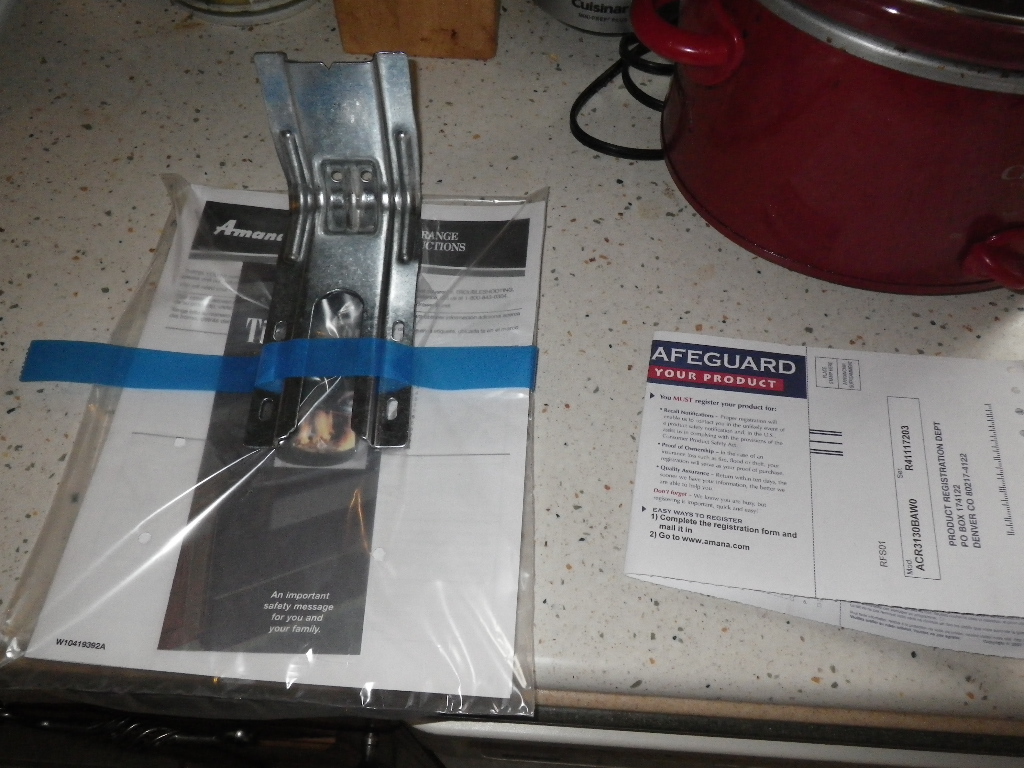 One of the many things I look for in an inspection.
For those that haven't seen one of these before, the anti-tip bracket is a device that is installed to keep a free-standing appliance from falling over. This can happen in a variety of ways, from innocent babies climbing on the door when it's down, to the elderly grasping the edge to avoid falling to . . . well, failures of human intelligence.
One of the many things I look for in an inspection.
For those that haven't seen one of these before, the anti-tip bracket is a device that is installed to keep a free-standing appliance from falling over. This can happen in a variety of ways, from innocent babies climbing on the door when it's down, to the elderly grasping the edge to avoid falling to . . . well, failures of human intelligence.
(The only part about the video that surprises me is that it was a young lady - doing as much work as I do around university campuses, this is the sort of thing I expected to see from a frat house.)
There are two ways to secure the stove. It's not very complicated. The one in my picture is a floor mount that has a slot for the rear leg of the stove to slide into. The second method, not used as much any more, is to use a bracket that attached to the wall with a hook on the back of the stove.
Installers don't like to spend the extra time since they always have a 'next' job to get to. Not installing it, though, voids the manufacturer's responsibility if the stove does tip.
On a side note - a daughter of mine didn't understand why I checked for them, until her daughter climbed the stove. Now she gets it. And keeps telling my grand-daughter - who's a peach - to quit it.
Railroad tie retaining walls
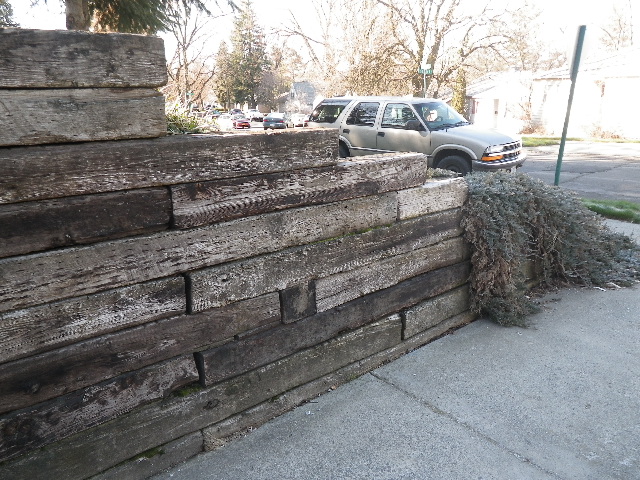 In Pullman and Moscow both, a ‘natural-look’ trend using railroad tie retaining walls took place from the mid-1980’s to about 2000, when masonry block supplanted the trend. The advantage of the railroad ties was the number of them dropped onto the market as local rail lines got torn up and the creosoted wood was nearly given away.
As is usually the case, the contractors that first started using the ties had no idea of what a wall constructed of wood should look like. Mostly, they pretended that it was just like a concrete wall. They stacked the ties, drove spikes through them vertically and—viola’—counted it as good.
In Pullman and Moscow both, a ‘natural-look’ trend using railroad tie retaining walls took place from the mid-1980’s to about 2000, when masonry block supplanted the trend. The advantage of the railroad ties was the number of them dropped onto the market as local rail lines got torn up and the creosoted wood was nearly given away.
As is usually the case, the contractors that first started using the ties had no idea of what a wall constructed of wood should look like. Mostly, they pretended that it was just like a concrete wall. They stacked the ties, drove spikes through them vertically and—viola’—counted it as good.
It wasn’t. The railroad ties are prone to rotating and the spikes aren’t enough to resist the motion. Add to that the ground pressure, especially when the native loess around here gets wet, and the retaining walls tend to pick up a lean pretty quickly.
There’s a way to fix the issue, though. At the time you build the wall, you include tiebacks. Tiebacks can be made with steel rods and use anchor bolts to flat plates at the outside of the wall. A more attractive solution that works equally well is to use the railroad ties themselves as the tiebacks by turning an appropriate number of them perpendicular to the wall, extending into the hillside you are retaining.
If you look at the railroad tie retaining wall in the picture, you can see a tieback in the lower middle part of the picture where the end profile of the tie is visible.
No, I can’t tell you the appropriate number of tiebacks – that is known as engineering and I’m not qualified. As an inspector, I recognize when this has been done (and hasn’t, obviously) and point it out to the client.
Now, for the other problem with using railroad ties in retaining walls, at least in Pullman and Moscow—the ties are a multi-story hotel for carpenter ants.
The creosote coating will keep them from penetrating the surface of the wood but any cut ends or sections that split will provide an entry point. Once inside, the carpenter ants will set up house. Unlike most other wood destroying organisms in the Pacific Northwest, the ants don’t eat the wood. They excavate and create shelters.
While their presence in the wall will weaken it, they’re not yet a threat to your home until they attempt to colonize it in the same manner they took over the railroad ties. As part of a home inspection in Washington State, the inspector is required to inform you of potential conditions conducive to this type of infestation. Note the difference . . . potential. Just because the condition exists, it does not automatically follow that an infestation is imminent.
It would be prudent to have a professional keep an eye on the potential for you and, if it’s a concern, provide treatment options. A pair of companies I like are Sunpest and Hayden Pest Control. {Disclaimer-Sunpest helps me with my dandelion issues.}
Railroad tie retaining walls are an attractive landscaping feature but, when buying a new home, look for the signs (or make sure your inspector looks) of good construction and be mindful of the pest issues. Otherwise, enjoy the natural beauty they bring.
Pregnant? New Home in the Country? Please - test your well for nitrates.
“I have a daughter in her childbearing years,” Brender said. “If she were on a private well, I would tell her to have her well-water tested or drink bottled water.”
There's a powerful emotional reason for her to encourage you to test your well for nitrates. That quote is from an article from NBC News about a rash of birth defects in the Yakima area. The children affected have anencephaly, a condition in which they’re born missing parts of the brain or skull.
The CDC hasn't issued a reason for the sudden rash, or cluster as they phrase it, of birth defects, but they also admit that they haven't done the kind of intense in-person and in-place survey likely to find an obscure cause, something that might be as simple as they all purchased produce from the same farmer.
Yakima is a major growing area in Washington State, especially for fruits and vegetables while the regions to the East, the Palouse tend more towards grain and legumes. Still, they share a commonality - fertilizers and pesticides.
Research has shown that there are potential links between anencephaly and exposure to molds and to pesticides, Ashley-Koch said. Central Washington is a prime agricultural area that produces crops from apples and cherries to potatoes and wheat, which may require pesticides that contain nitrates.
So, if you are in a young family, planning on children and buying a home with a private well, please spend the $75 (or thereabouts - I haven't priced it recently) to get the well tested.
You never know - the money you spend to test your well for nitrates may end up being the best investment you've ever made for your children.
So what happens if it DOES snow?
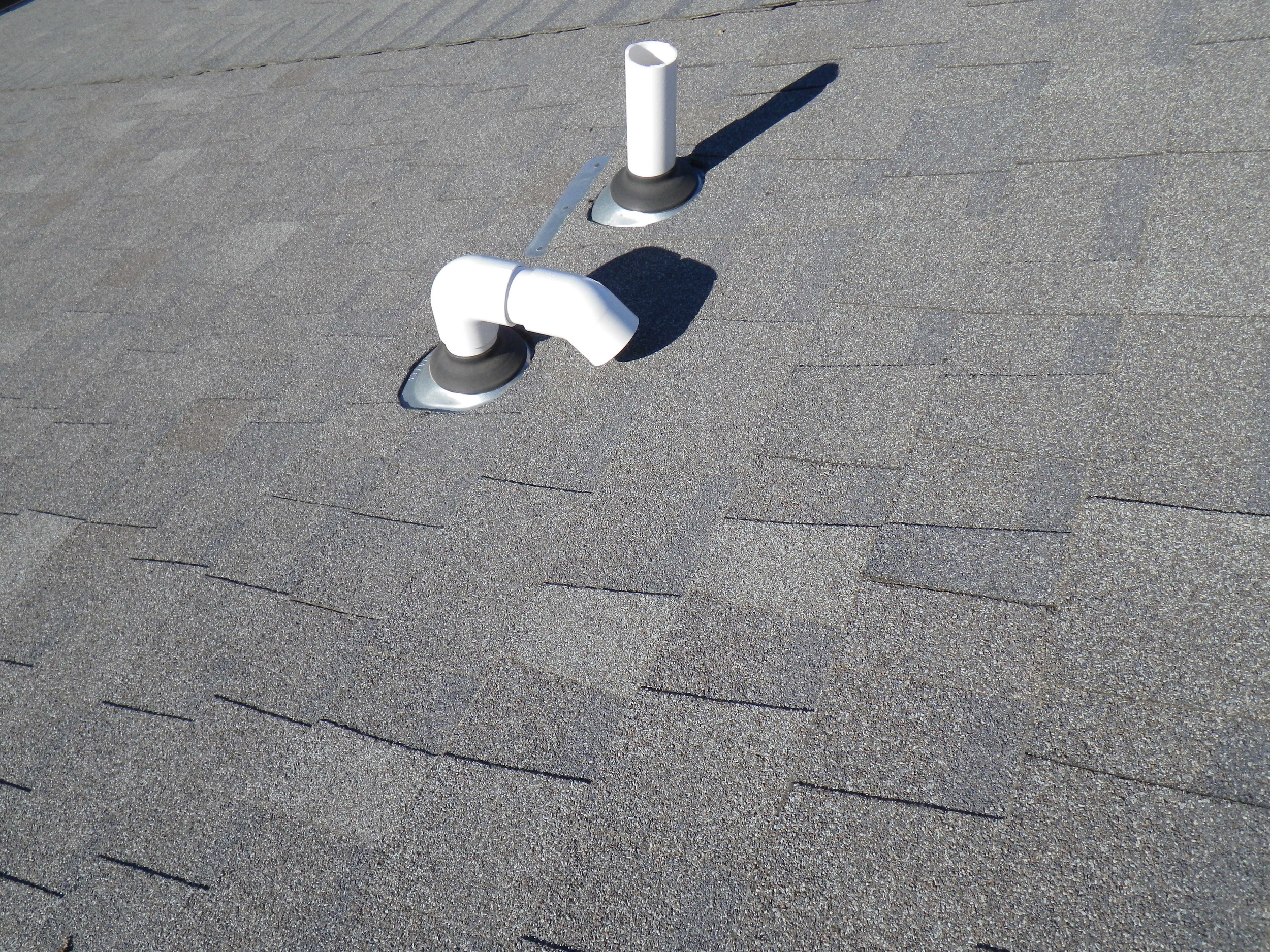 One advantage of living in Asotin is that the whole Lewis-Clark valley is considered to be a 'banana belt'- we're normally 10 degrees warmer than the surrounding prairies.
We're also a desert. The average rainfall in Lewiston, Idaho is about 13 inches per year. Pullman get about 20 inches which makes it a semi-arid desert but the great soil in the Palouse hold water well and allows for dry land farming. A lot of their moisture happens this time of year, in the form of snow.
One advantage of living in Asotin is that the whole Lewis-Clark valley is considered to be a 'banana belt'- we're normally 10 degrees warmer than the surrounding prairies.
We're also a desert. The average rainfall in Lewiston, Idaho is about 13 inches per year. Pullman get about 20 inches which makes it a semi-arid desert but the great soil in the Palouse hold water well and allows for dry land farming. A lot of their moisture happens this time of year, in the form of snow.
In the valley, we snicker. Most of the time, if we get 'snow', it's a dusting and we broom it off as we get on our way. Very little fuss.
This leads the builders in the valley to occasionally entertain bad ideas on what constitutes good construction. If you take a quick gander at the picture above, you can see a prime example.
The picture was taken on an inspection of a brand new home. Can you see the problem?
Yep, whoever it was that pointed out the air intake (the curved one) is way too close to the roof deck wins a Tootsie Pop.
The intake should be much high off the roof deck (I recommended 12") so that, in the event of snow, it doesn't get blocked. The ultra-high efficiency furnace that is connected to the intake has a sensor that measures how much combustion air is getting pulled in. If it doesn't sense enough air, the furnace will not start.
Bad.
It's winter and we definitely want the furnace to fire off and keep our tushes warm. We also don't want to make a service call (on overtime rate because it always happens that way - Murphy's Law is immutable and irrepressible) to get a perfectly acceptable system working again. And even if you know what the problem is, do you really want to climb onto a snow covered roof to fix it?
This is an easy fix. Add some height to both the exhaust and air intake. Viola, end of this particular problem.
And yes, it should have been caught by the building official but cut them a little slack. Like the rest of us, they're human and can miss something. Yes, it should have been caught by everybody up and down the construction cycle. That's why you hire an inspector, even for new homes-we're the last link in the chain of people (builder, contractors, code official, agent, inspector) that are trying to make you happy in your new home.
Keep that intake clear and stay warm, folks.
Prep Season
We've cleared the holidays when everyone in real estate takes some time off. No one wants to move at Christmas so many folks don't have their house on the market, waiting instead until after the New Year. In other words, now. I'm starting to see a strong uptick in seller's inspections as folks prep their house for entry into the market. Something to consider is that the first audience for your home is the other real estate agents. Once listed, they'll be touring your home so that they can be ready to refer their clients to appropriate properties.
If you have any little projects (and maybe some big ones) that you want to complete during the late winter/early spring, talk to your agent about waiting until the projects are complete before putting the house up on tour. First impressions can be critical and you don't want to jump the gun.
And, if your agent has suggested some repairs, I strongly recommend that you consider them. They know what is concerning to the buyer - they work with them daily.
For more advice on sellers inspections, check out my posts here.
Crawl Space Access
Crawl space access is one of those completely unsexy things that inspectors get excited about - and with good reason, since we get paid to go in there. Most homebuyers take one look at the spider webs and confined space and pat me on the back. "Good luck, take pictures." seems to the general idea. They're not coming with me. Accesses get placed in all sorts of interesting spots - outside, in the garage, through a basement wall, closets - you name it, someone has put it there.
Okay, not the attic. We'll save the discussion of attic scuttles for another time. . .
The code for crawl space access is pretty specific.
R408.4 Access Access shall be provided to all under-floor spaces. Access openings through the floor shall be a minimum of 18 inches by 24 inches (457 mm by 610 mm). Openings through a perimeter wall shall be not less than 16 inches by 24 inches (407 mm x 610 mm). When any portion of the through-wall access is below grade, an areaway not less than 16 inches by 24 inches (407 mm x 610 mm) shall be provided. The bottom of the areaway shall be below the threshold of the access opening. Through wall access openings shall not be located under a door to the residence.
Did you read all that? No, don't worry. The inspector will manage it. Heck, we're delighted if we actually get a code-compliant hatch in an older home. Some that I've gone through are a half or less of the size above. It's why you should always hire a skinny inspector.
No, the part that will drive the inspector nuts and possibly cost you money (if you're the buyer) or a sale (if you're the seller) is having a perfectly acceptable hatch that isn't accessible.
Don't Cover or Block the Crawl Space Access
Yesterday was a classic example. We have a home with a sloped floor, a large tree five feet from the foundation wall, and no way to check the crawlspace for structural damage because the hatch was in the laundry room. Under the washer/dryer.
Very few inspectors are going to move installed appliances, risking damage to the appliances and the flooring, to get to a hatch. Instead, most will write it up as a defect, mark the structural components as uninspected and leave the buyer guessing about sloped floors.
The longer they guess, the worse the problem will get in their minds.
If you are the seller, please do yourself a favor. First, know where your access is. If it's under equipment, take the time to move things for the inspector.
If it's in a closet, remove your personal possessions to leave it available. Same thing for exterior hatches - don't stack the firewood on top.
Some older homes will have the hatch nailed down. If this is the case, pry it up before the inspector gets there. The odds are that he or she won't take the chance of damaging flooring.
And if you're using screws to hold the covers in place - frequently done on exterior hatches to keep the board tight to the wall - use a standards screw head - no need to go with fancy star-patterned heads. We might not have that particular pattern or size on board the truck. Use a Phillips or square head screw.
The inspector will thank you, and the buyer will get the information they need without the extra worrying. And you move one step closer to a successful sale.
EPA Bans Most Wood-Burning Stoves
Well, it's not like we're not used to the EPA overreaching on regulations so a production ban on the types of wood-burning stoves found in about 80 percent of the homes nationwide with stoves shouldn't be a surprise. The core of the issue is a requirement that wood stoves produce less than 12 micrograms per cubic meter of air of airborne fine-particle matter. The old standard was 15 percent.
You can still use your old wood stove - for now, and depending on region - but if you want to get a new stove, the old one will need to be scrapped out. You can't sell it to another party to recoup some of your outlay for the more efficient burner. I also suspect that the new regulations will increase the cost of the new wood-burning stoves as well though the EPA helpfully provides a list of compliant stoves.
Some areas of the country already ban outright the use of a wood stove during certain weather conditions or seasonally. Puget Sound and the Air Resources Board in that region have done that.
If you are buying a home with a wood stove, I would strongly suggest finding out if the stove is compliant. As an inspector, this isn't going to be part of my routine since there is too great a variety in the stoves themselves. Also, I would keep in mind the fact that the stove that you have may be banned from use should the local jurisdictions decide that it is necessary. Such bans almost invariably involve the traditional fireplace as well.
If you are a seller with a new wood-burning stove that is EPA compliant, I would include that information in the listing. Discuss it with your Realtor to see how best to do this.
For more info, here's the article that I found - EPA Bans Most Wood-Burning Stoves
Your Home Inspection Report is Confidential Info
 Your Home Inspection Report is Confidential Info
Your Home Inspection Report is Confidential Info
About twice a year, I end up explaining to a peeved Realtor that I can't send them copies of inspection reports because the information is confidential and it violates state regulations to release it without the customer's permission.
The last time I pointed this out, the Realtor sent me an email that I took as disagreeing with this. To quote, "Paul that is stupid..." I had sent a copy of the report to a partnering agent who apparently did not realize that it landed in his junk folder and she didn't see why I couldn't send it to her since they share an office.
The answer was that I am not permitted to. Here's the relevant Washington Standard:
308-408C-020WAC 308-408C-020 Ethics. Statement of purpose
In order to ensure the integrity and high standard of skill and practice in the home inspection profession, the following rules of conduct and ethics shall be binding upon the inspector. The home inspector must:
(10) Not disclose information contained in the inspection report without client approval or as required by law.
Seems clear enough. In this particular case, I did the inspection for a person buying the home on a For Sale by Owner basis but was seeking advice from a licensed Realtor. All good, except that at the inspection, he didn't provide me with that information so that I could pre-clear the sending of the report.
By pre-clear, I mean that I have a spot in the Inspection Agreement where the customer can affirmatively check a box that gives me permission to disclose his or her inspection information to his or her agent. It still wouldn't have gotten the report into the hands of the second agent, though.
There is an exception:
However, at their discretion inspectors may disclose when practical observed safety or health hazards to occupants or others that are exposed to such hazards.
If the gas odor clubs me at the door of the house (and it happens more than you think), I can notify the occupants or others that the condition exists. That doesn't mean that I'm calling Avista to have them fix it. That's miles beyond the scope of my authority. But I can act in the interest of public safety and disclose information.
So, the bottom line for the customer. Your home inspection report is confidential information and you don't have to share it. Certainly, your inspector should never share it without your say-so.
Should the Seller Hire an Inspector? Part 3
This is Part 3 of Should the Seller Hire an Inspector? Feel free to offer comments and suggestions.
How to Pick your Inspector
One of the best compliments I ever received came from a client who had used me on a small commercial project. The project was interesting - a turn-of-the-century storefront. He called me up later to inspect his home before he sold it. His reasoning? He wanted to take the best home inspector off the market forcing the buyers to select a lesser inspector.
I am going to presume that you, like most people, do not have a home inspector on speed dial. If you decide that a pre-listing inspection makes sense for you, let’s look at the factors that you will need to evaluate in order to hire the right inspector.
Experience. You need to have an inspector that has the professional background - education, time in the field, previous occupations - to be as thorough as possible. You should expect no less than five years of inspector experience in you region. Previous experience in the building trades or as a code certified inspector is a plus.
Licensed. Not every state has licensure but if yours does, your inspector must be licensed. If things get contentious, the more qualified your inspector, the more likely you are to prevail. Licensing is the entry level requirement. Look for additional certifications from ASHI (American Society of Home Inspectors) or NAHI (National Association of Home Inspectors). Ask to see copies of his professional license as well as any applicable business licenses.
Reports. You need a detailed report preferably in a narrative format that will detail the specific condition that needs correction. The inspector should be willing to do a follow-up inspection to document that repairs were made. Expect to pay extra for this service.
Insured. As I mentioned before, the inspector should be carrying E&O insurance as well as General Liability insurance. Ask to see copies of his insurance binders.
You will note that I did not specify the fee. While the fee is important to you, we are looking for a level of exceptional service. A typical home inspection is going to cost somewhere between $300 and $500 depending on your region, the size of your home and the level of services involved. Each region will have different pricing structures with some adding for building elements such as crawlspaces or charging extra for older homes. Definitely ask but be aware that the low cost bidder is likely the one that lacks the other primary credentials that you need.
Another element to look for is a guarantee from the inspector. When I do a pre-listing inspection, I offer the following promise:
I guarantee my inspection like this: if another inspector working for the buyer finds something that I missed that is included in my Standards of Practice, I’ll pay for the repairs up to the cost of your inspection.
Most inspectors are not going to voluntarily offer a guarantee so it’s up to you to ask. The best inspectors will have some way of backing up their work. Those are the ones that you want to work with.
Speaking of services, I will be covering environmental issues in Chapter 8 along with some of the specialty inspections that are offered in the marketplace. I do not necessarily recommend that you do all of them but I want you to be aware of them so that you are not surprised if your buyer decides to access a higher level of information.
For now, you have enough information to have a candid conversation with your real estate agent. Discuss with them the advantages and disadvantages of performing a pre-listing inspection on your home and make the decision from an informed basis.
This is the final installment of the article, Should the Seller Hire an Inspector? If you found it helpful, drop me a note. If you have suggestions, I would love to hear from you.
Re-Tooling the Inspection Report
Well, it's back to the drawing board for my inspection report. One of the reasons I chose the software I have is to be able to periodically improve my report. That never happens in the summer, of course, because I'm entirely too busy. Now that things are slowing down for the season, I can make all the adjustments on all the stuff that has been annoying me for the last six months, plus add in all the suggestions that clients and agents have made.
As an industry, this is one weakness that I have observed. The inspector gets married to a single method of reporting and simply never changes it. There are inspectors in my area still using the exact same reporting system that they started with years ago. News flash - the standards are constantly evolving and the inspector ought to as well.
By next month, I should have the system rebuilt. One of the goals is to greatly increase the detail of the descriptions. Many agents will consider this to be TMI - Too Much Information - but I see large changes ahead for the inspection industry. I'd rather ride the wave of the change than get drowned in it.
Improving the Inspection Report is just one small part of riding that wave.
Washington State License #215
Former SBCC Member, Former Chairman State Home Inspector Advisory Licensing Board.







